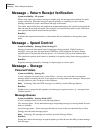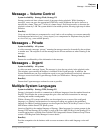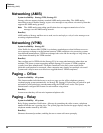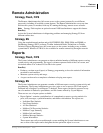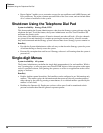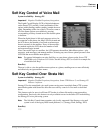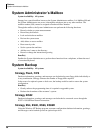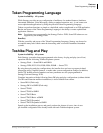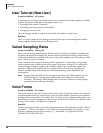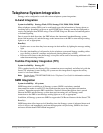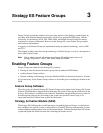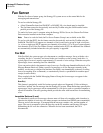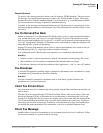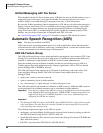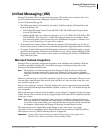
Features
User Tutorial (New User)
40 Stratagy General Description 01/03
User Tutorial (New User)
System Availability: All systems
A first time user of Stratagy automatically hears a user-friendly tutorial upon logging in to his/her
mailbox. The tutorial walks the user through the process of:
• Recording his/her name (if required)
• Recording a personal greeting for the mailbox
• Changing the security code
Once the Stratagy tutorial is completed successfully, the mailbox is ready for use.
Benefit(s)
The User Tutorial walks the new Stratagy user through the steps of customizing their mailbox,
thereby reducing training time for new Stratagy users.
Varied Sampling Rates
System Availability: Stratagy ES
The system can be programmed to play different types of recordings at different “sampling rates.”
In general, the higher the sampling rate, the more accurate the digital recording of the incoming
sound, and the better the reproduction. However, using a high sampling rate means that more disk
space is taken by a given recording.
Since companies wish to present the best possible “appearance” to their callers, and greetings
usually represent only a small fraction of the system’s disk space, Stratagy ES is configured to
record greetings at a higher sampling rate of 64Kbps (kilobits per second) than regular voice
messages (32Kbps). The sampling rate for greetings and for voice message recordings can,
however, be individually set by the System Administrator during system installation and
configuration.
Note Stratagy Flash and IVP8 and do not support this feature. The IVP8 sampling rates are
fixed at 64 kbps for system prompts and greetings, and 32 kbps for voice message
recordings. The Stratagy Flash sampling rates are fixed at 24 kbps for system prompts,
greetings and voice message recordings.
Voice Forms
System Availability: All systems
The system can be configured to prompt a caller with a series of questions and the voice responses
concatenated and stored as a single message in the associated mailbox. Questions are recorded as
greetings, either in that mailbox or in others. The “Q” token is used to implement this feature (for
more details see Token Programming in the Stratagy Installation and Maintenance Manual or the
Stratagy ES Installation and Maintenance Manual).
Benefit(s)
Voice Forms are an excellent way to collect information from a caller. Questions could be “What is
your name?”, “What is your address?”, and “What is your phone number?” In response, a single
message containing the responses are stored, e.g., “John Smith, 123 Apple Drive, Irvine,
California 92718, (949) 555-1234.”



